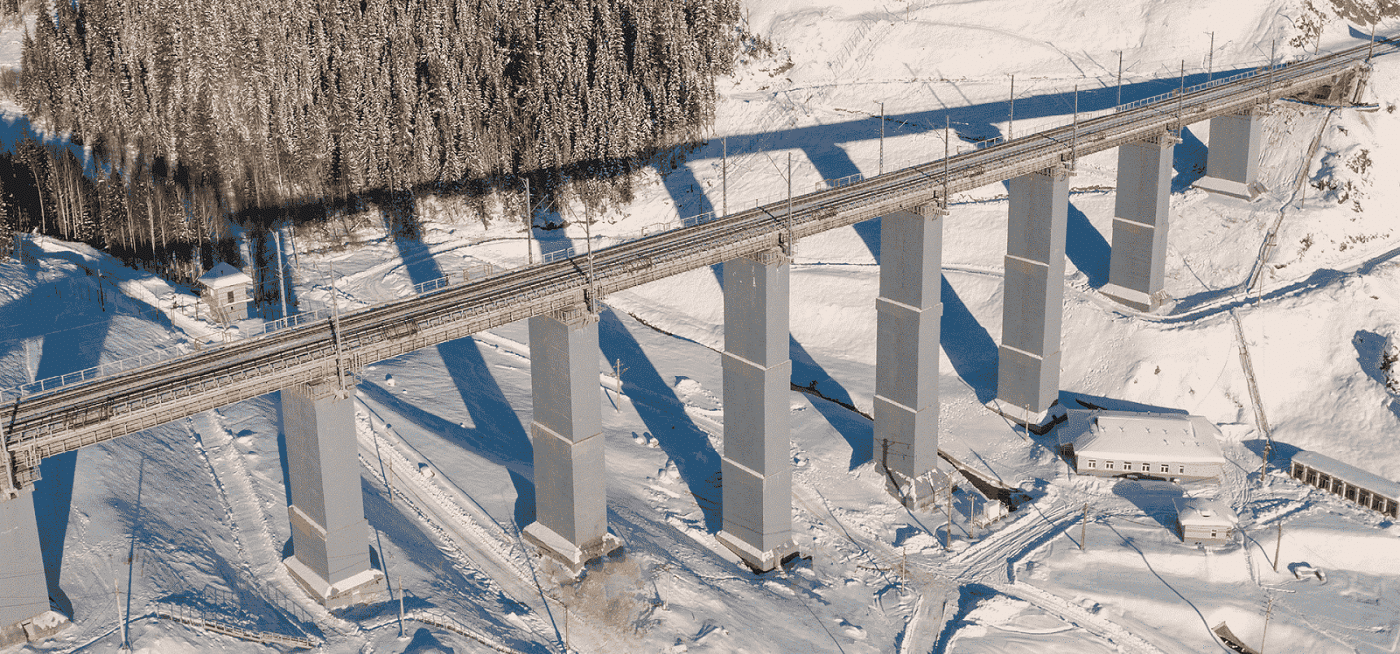Railway transportation and infrastructure
 It was in 2020 that we had a chance to assess our own circumstances and improve existing routines. In this challenging environment, we did our best to make the most of available resources and ensure uninterrupted use of our railway network. We managed to deliver on the Comprehensive Plan for Upgrading and Expanding Core Infrastructure through the concerted efforts of all business units aimed at infrastructure debottlenecking and improvements in transportation technologies.Anatoly Krasnoshchek First Deputy CEO of Russian Railways
It was in 2020 that we had a chance to assess our own circumstances and improve existing routines. In this challenging environment, we did our best to make the most of available resources and ensure uninterrupted use of our railway network. We managed to deliver on the Comprehensive Plan for Upgrading and Expanding Core Infrastructure through the concerted efforts of all business units aimed at infrastructure debottlenecking and improvements in transportation technologies.Anatoly Krasnoshchek First Deputy CEO of Russian Railways
The railway transportation and infrastructure segment covers core business units engaged in railway transportation management, maintenance and development of infrastructure and locomotive fleet. The Company’s operating and financial performance is directly linked to their efficiency, effectiveness and technical cooperation.
Key focus areas of the Long-Term Development Programme
Key initiatives in rail transportation and infrastructure development include:
- developing operating domain-centred transportation management principles across the Russian Railways network;
- creating dedicated infrastructure for passenger and freight transportation;
- boosting efficiency of low intensity railway lines;
- enhancing transportation efficiency through quality improvements in utilisation of the rolling stock;
- developing marshalling yards;
- improving management of the freight car fleet;
- bolstering utilisation efficiency of mainline and shuntering locomotives and locomotive crews;
- upgrading railway tracks applying new technology and using elements and structures of equally high quality to reduce costs associated with the infrastructure maintenance life cycle;
- introducing automation equipment with moving blocks within sections, including a distributed computer-based interlocking system at stations with identification of main tracks, differentiated departure sections and automatic cab signalling;
- establishing extended guarantee sections ensuring safe passage of freight trains;
- creating an operating domain-centred model for operation of work trains and diagnostic machinery;
- removing energy-related restrictions;
- preparing infrastructure facilities for passage of heavy-duty and long trains;
- streamlining planning for repairs and maintenance of infrastructure facilities and associated scheduling processes;
- improving train composition planning and train passage management systems;
- using natural gas as a motor fuel, gradually expanding the use of gas powered locomotives (gas turbine locomotives, gas powered diesel locomotives used in shuntering operations), while also working to improve design and increase efficiency at locomotive plants when developing modern servicing stations and LNG refuelling mechanisms.
Russian Railways’ goals for developing railway infrastructure until 2025:
- achieve an increase in the throughput capacity of the Baikal–Amur and Trans-Siberian Railways to 180 mt by 2024;
- boost the throughput capacity of the rail infrastructure serving ports of the Azov and Black Seas;
- reduce container travel times from the Far East to Russia’s western border to seven days and achieve a fourfold increase in the transit container traffic by 2024;
- develop high-speed and ultra high-speed railway services between and within major cities and metropolitan areas;
- develop transportation services between regional administrative centres and other cities of major economic activity;
- create multimodal freight transportation and logistics hubs.
- The Company handled 1.2 bn t of cargo.
- We exceeded the last year’s export volumes by more than 11 mt of coal (up 7.6% y-o-y).
- Handling of containerised cargoes grew by 16.5% vs 2019.
- Total freight turnover amounted to 3,221.0 bn tkm.
- The loaded car delivery speed rose to 439.4 km/day, up 11.4% vs 2019.
- The share of shipments delivered within required period increased by 1 pp vs 2019, reaching 99.4%.
- In 2020, 46,300 trains (up 6.6% y-o-y) were dispatched as scheduled with fixed departure and arrival times.
- A total of 2,400 trains (up 24.8% y-o-y) were dispatched as part of the Freight Express service.
- The Company dispatched 29,200 trains weighing over 7 kt (up 21% vs 2019).
- In 2020, we renovated over 5,500 km of tracks and laid more than 2,000 sets of turnouts, which helped keep down the length of railway tracks with exceeded limits of throughput, reduce the length of permanent speed limit sections and increase the train speed on 1,100 km of tracks.
- Russian Railways ensured that 63% of track overhauls using new materials and 57% of full replacements and intermediate overhauls were carried out on traffic-free sections. In 2020, diagnostic machinery performance improved by 16% y-o-y, with the share of incident detections by mobile diagnostic tools quadrupling to 21% over the past five years.
| Item | 2020 performance | % vs 2019 |
|---|---|---|
| Average weight of freight train, t | 4,084.0 | −0.1 |
| Schedule speed of freight train, km/h | 41.6 | +1.0 |
| Average operating speed, km/h | 46.6 | +0.4 |
| Average daily performance of freight locomotive, thousand tkm gross | 1,677.0 | +4.2 |
| Average daily performance of freight train locomotive, thousand tkm gross | 2,216.0 | +3.6 |
| Per unit electricity consumption for train traction, kWh/10,000 tkm gross | 106.2 | −1.2 |
| Per unit fuel consumption for train traction, kg of reference fuel/10,000 tkm gross | 55.5 | +0.1 |
Repairs and upgrade of infrastructure facilities
In 2020, the Company spent RUB 127.1 bn on all types of track repairs and renovated 5,480.8 km of tracks, with the Eastern Operating Domain accounting for over a quarter of all repairs.
Track overhaul and maintenance in 2020 helped:
- increase the speed of passenger and freight trains on 1,115.6 and 1,119.3 km of tracks, respectively;
- increase the average speed of passenger and freight trains by 0.2 km/h (to 93.6 km/h) and 0.1 km/h (to 73.5 km/h), respectively;
- improve track condition assessment by 1 point y-o-y to 33 points;
- reduce equipment failures by 27% (247,700 in 2020 vs 338,300 in 2019);
- keep the length of railway tracks with exceeded limits of throughput or useful life flat vs 2019 at 23,900 km.

In 2020, Russian Railways completed the renovation of the Krasnoyarsk Railway's 326 m long Kozinsky viaduct. We had to replace the 50-year-old bridge at a height of 65 m on the most challenging pass of the

In 2020, Russian Railways built a new railway bridge across the Akhtuba River in the Krasnoyarsky District of the Astrakhan Region. The new bridge is a key to boosting the throughput capacity of the rail infrastructure serving ports of the Azov and Black Seas. Its launch helps eliminate the last single-track bottleneck between Baskunchak and Astrakhan thus enabling heavy-duty freight traffic. The bridge crossing will also increase the throughput capacity of the North-South corridor en route to Moscow and Kazakhstan.
With the new bridge opened, freight traffic is expected to reach 20 million tons with its throughput capacity set to rise to 153 train pairs per day. The bridge crossing is 2.35 km long and consists of 8 pillars and 7 spans. The bridge was inaugurated on 19 February 2021, when the Privolzhsk Railway turns 150.
It was constructed using state-of-the-art engineering solutions, with strain pole foundations laid to a depth of 18 to 33 m and pile tops combined with reinforced concrete grillage. Bridge spans were assembled on site. Structural steel relies on crossbeams, as well as longitudinal and lateral ties supporting the lower boom. We also laid reinforced concrete panels for ballastless track. Russian Railways invested shareholders received 3 bn in the construction.
Streamlining the freight traffic schedule
The main function of the train schedule is to maximise the infrastructure efficiency for the required throughput and carrying capacity, ensure the target volume of freight traffic and increase the schedule and mean speed.
Russian Railways’ timetable provides for over 900 special routes, including 595 container trains, 16 RoLa trains, 149 Freight Express trains, 53 coal trains, 30 timber trains, 8 Cargo Lowcoster trains.
Improving performance at operating domains
To this end, the Company strives to streamline train composition planning coupled with schedule improvements. In 2020, the share of full train shipments rose by 1.5 pp (to 53.3% of all dispatched loaded freight cars), which helped reduce yard operations by 4,000 cars per day vs 2019.
Developing passenger infrastructure
In 2020, the Central Transport Hub met its target for passenger transportation with 548.9 m people transported annually. Russian Railways completed an all-time high RUB 99.3 bn worth of works (101.4% of the plan) as part of the Central Transport Hub development project. The Company commissioned passenger and transport infrastructure facilities for a total of RUB 54.2 bn, exceeding the plan by half.
In 2020, Russian Railways managed to increase the train speed on the Centre–South axis, specifically on Moscow–Ryazhsk–Adler–Moscow (176 km) and Moscow–Yelets–Adler–Moscow (186 km) routes, thus reducing travel times by 10 minutes on each route.
Developing infrastructure to support growing transit container volumes
In 2020, the Company updated its action plans to enhance the throughput and carrying capacity of its infrastructure to deliver a fourfold increase in transit container traffic by 2025.
The average speed of transit container trains in 2020 stood at 1,074 km/day, or 7.6% above the target set in the Comprehensive Plan for Upgrading and Expanding Core Infrastructure (998 km/day). Russian Railways hit an all-time high with some 5.8 m TEU containers transported in 2020, up 15.9 y-o-y.
Traction stock in 2020
In 2020, Russian Railways spent RUB 94.3 bn on traction stock purchases, with all locomotives made in Russia. The Company procured 566 locomotives, including:
- 328 mainline electric locomotives, including 294 freight and 34 passenger locomotives;
- 238 diesel locomotives, including 154 shunting, 80 freight mainliners and 4 passenger locomotives.
Train traction accounts for the bulk of Russian Railways’ fuel and energy expenses, so energy saving initiatives are high on the agenda. Over 4,000 locomotives have been equipped with automatic train operation systems that control their movement and minimise energy consumption. In 2021, the project will be rolled out across the entire railway network.
In 2020, per unit electricity consumption for train traction amounted to 106.2 kWh/10,000 tkm gross (down 1.2% y-o-y), while per unit fuel consumption for train traction stood at 55.5 kg of y-o-y), while per unit fuel consumption for train traction stood at 55.5 kg of reference fuel/10,000 tkm gross (up 0.1% y-o-y).
Developing heavy-duty traffic
Heavy-duty traffic and higher weight standards of freight trains are key to optimising the transportation process in terms of increasing the carrying capacity, enhancing performance of locomotives and locomotive crews and reducing energy consumption for train traction.
Russian Railways continues to develop heavy-duty traffic. Following pilot tests in 2020 and thanks to new locomotive purchases, the Company managed to increase allowable weight limits on more than 46 sections. The average train weight across the network increased by 11 t vs the plan on the back of composition and operation of heavy-duty and push-pull freight trains, including:
- 161,900 runs by trains weighing over 6 kt;
- 42,400 runs by push-pull trains.